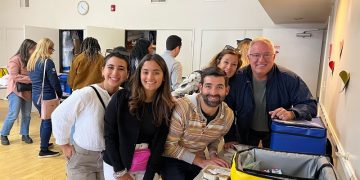
This is the last SMart article in an expanding 5 part series about our City’s power, water, and food prospects. These three factors are essential to the City’s prosperity and, more importantly, to its sustainability and survivability. Last week’s article covered the importance of building power storage capacity (https://smmirror.com/2024/08/sm-a-r-t-column-your-homes-first-battery-is-in-your-car/) because our best, cheapest energy sources, (wind and solar photovoltaic) fluctuate massively in day night and seasonal cycles. Specifically, car batteries could absorb some of that surplus fluctuating power generated by those sources (and when not needed for the car’s mobility) could feed it back into your home or business. Because electric cars have relatively large batteries and are increasing in number, they will be the City’s first widely distributed, industrial-scale power storage facility.
Abundant Green Power
As we increasingly meet all of California’s power needs for longer periods of time from fluctuating solar and wind sources, there will be more and more times when we have clean “surplus” power. We could “dump” that extra power into the grid of adjacent states, but we would suffer substantial transmission losses, not to mention pricing issues. It would be better to store it in local batteries of various forms for immediate nighttime use and seismic survivability or even use it to make hydrogen. Hydrogen is made by electrically “stripping” hydrogen molecules off, for example, water. The advantage is if the electricity used to make it comes from clean, renewable sources, that hydrogen fuel, while expensive, is clean burning (no greenhouse gases or combustion particle pollution) and the only byproduct of burning hydrogen is essentially water vapor. But, the real advantage of hydrogen is that it has the power density closer to gasoline or to carcinogenic diesel fuel. This power density means it will become the main clean power source for the heavy load industry: trains, trucks, ships, etc., e.g., uses that will never have enough power capacity if they have to carry around heavy conventional batteries. Think of hydrogen fuel as a “battery” in another form. While the hydrogen power infrastructure is still in its infancy, at a primitive level even weaker than the sporadic power recharging available to electric cars today, it will eventually dominate the heavy load market.
Another advantage of local battery storage is as SCE transitions to time-of-use pricing, battery-equipped homes, and businesses can partially or fully shift, by using batteries, their peak use time to the hours when power is cheaper. We already have available pricy Tesla batteries and their cousins for immediate local storage, providing that advantage and improving survivability to both brownouts and seismic events. Just like solar panels and windmills, whose prices have fallen dramatically in the last decade, battery technology will follow the same falling price arc as its demand ramps up. Naturally, a hospital, police station, school, or business with balanced solar photovoltaic collectors and storage capacity can keep operating during our inevitable brownouts. As previously discussed, there are still some needed switching technology improvements for this transition to happen seamlessly, but those are on their way too.
Power Independence
But for a full transition to clean, 100% renewable energy, we need industrial scaled urban capacity batteries. Batteries are rapidly improving beyond the rare earth minerals that commonly power, for example, your I phone. Batteries are being tested made from a wide variety of exotic and ordinary materials. (e.g., sand, compressed air, etc.). They can even be made by altering the use of existing power facilities. For example, during times of extra solar/wind power we can pump the water back up behind hydroelectric dams to reuse their increased hydro flow at night. In a relatively short amount of time, appropriate lower-cost material, arrangement, and pricing of power storage capacity on an urban scale will emerge. While massive future warehouses of batteries, similar to the huge server farms powering the crypto phenomenon, may eventually emerge as the most effective storage solution, a redundant diffuse capacity is probably the best for redundant survivability. This is similar to having thousands of distributed rooftop solar collectors converting sunlight to power for thousands of homes and businesses rather than having a few concentrated and possibly vulnerable power plants (e.g., Ukraine’s vulnerable grid). A diffuse distribution power/storage solution also appeals to the American spirit of independence. Freedom from the grid, while still benefitting from it as a standby, is a positive value not just for survivalists but also for everyday citizens who understand how fragile our food, water, and energy grid has become.
So in the high stakes three-way race of increasing power demand vs increasing clean power supply and increased power storage capacity, any building we build, should in some way always be helping to solve these real issues. Even electric cars which inevitably increase power demand, may also provide some mitigation by providing some accessible power storage. Modern homes and buildings up to three stories can provide and improve all three but are not yet required to store some of the power they can generate. A typical apartment building, while increasing demand, also can mitigate it by increased rooftop power supply and often has room for future storage batteries. Codes for these types of buildings should already be emphasizing power production and storage, since it is going to be inevitably needed sooner than we think.
Unfortunately, skyscrapers, which are starting to flood our City, massively increase power demand but have virtually no supply capability on their minuscule rooftops (without some future unknown breakthrough technologies) and fatally are not required to provide any storage capacity at all. For this reason, once built, they will become a permanent burden on our ecological future: they are an ecological mortgage that can never be paid off. They crush and devalue not only all the adjacent properties but also the beach side spirit of our City; Sacramento-incited developers are like sharks in a skyscraper-feeding frenzy that is permanently transforming our City for the worst and will continue to degrade its survivability for decades.
At a June rally in Nevada, Republican presidential candidate Trump raised a scary scenario of being caught in a sinking electrically powered boat encircled by a hungry shark. He faced the hypothetical choice of being either electrocuted by the boat’s wet battery or eaten by the shark. So perhaps we can use battery requirements to slow down the skyscraper sharks devouring our City. The least the City should do is require massive battery storage capacity in skyscrapers. In the subterranean floors of those skyscrapers that would have been filled with parking (before Sacramento eliminated all parking requirements), we could have beneficial batteries. The City already forces new homes to provide all their power from rooftop solar collectors at the owner’s expense, but also as a real public benefit. Likewise, skyscrapers who are useless at power production should provide substantial storage capacity at the owner’s cost but also as a public benefit. So that even if they’re seemingly inevitable, they can at least be in the smallest way, not totally negative.
By Mario Fonda-Bonardi AIA
S.M.a.r.t Santa Monica Architects for a Responsible Tomorrow
Thane Roberts, Architect, Mario Fonda-Bonardi AIA, Robert H. Taylor AIA, Architect, Dan Jansenson, Architect & Building and Fire-Life Safety Commission, Samuel Tolkin Architect & Planning Commissioner, Michael Jolly, AIR-CRE Marie Standing. Jack Hillbrand AIA
For previous articles, see www.santamonicaarch.wordpress.com/writing













